Content marketing encompasses a lot. After all, every good marketing strategy, whether it be paid media, organic social, or lifecycle marketing, starts with high-quality content. Therefore, content marketing is the strategic creation and distribution of valuable, relevant content designed to attract, engage, and retain a clearly defined audience. Behind every successful brand is a comprehensive content marketing strategy that covers all stages of the digital marketing funnel.
Let’s take a look at what content marketing really is, why it’s important, and how to make it work for your brand.
What Is Content Marketing?
Content marketing is how brands show up, whether it’s on people’s feeds, in their inboxes, or anywhere else consumers are paying attention. It’s the bridge between what a brand wants to say and what an audience actually wants to hear.
At its core, content marketing is about creating and sharing valuable, relevant content to attract, engage, and retain an audience. But it’s more than just writing blog posts or posting on Instagram. It’s a long-term strategy with the goal of building a relationship with your audience by delivering consistent, high-quality content that speaks to their needs, interests, and behaviors.
Content marketing isn’t a one-size-fits-all approach. It spans a wide range of formats—articles, videos, infographics, emails, case studies, podcasts, and more—adapting to each stage of the customer journey. Whether you’re trying to educate potential customers, nurture leads, or reinforce brand loyalty, content is the tool that helps move people from passive viewers to active participants in your brand story.
At its core, the goal of content marketing is to build meaningful connections with audiences. It shifts marketing from a one-way broadcast to an ongoing conversation grounded in trust, value, and relevance. Brands that invest in content marketing aren’t just selling a product; they’re building a presence that lasts.
What Are the Different Types of Content Marketing?
One of content marketing’s strengths is its versatility—it can take on many forms, allowing marketers to reach diverse audiences through different formats.
To support a full-funnel content marketing strategy, brands should typically use a mix of content types. Here are some of the most common formats:
- Social media posts
- Long-form video
- Emails
- Blog articles
- Substack newsletters
- Podcasts
- Whitepapers
- Checklists
- Courses
- Quizzes and tools
Social Media & Content Marketing
Social media is one of the most common vehicles for content marketing. Whether it’s a viral TikTok, a behind-the-scenes Instagram Reel, or a thought-leadership thread on LinkedIn, social media allows content to travel fast, feel personal, and spark engagement in real time.
Successful social media content comes to life with a solid content strategy behind it. Every post, caption, and campaign should be rooted in a broader narrative—one that aligns with your brand voice, audience interests, and marketing goals. Content marketing gives your social efforts direction, ensuring you’re not just posting for the sake of it but creating moments that build awareness, drive traffic, and deepen loyalty. Spotify is a standout example. The streaming giant has mastered the art of using social content to reflect culture, not just promote its product. From its playful, hyper-relevant tweets to the much-anticipated annual “Spotify Wrapped” campaign, the brand turns listening habits into highly shareable content. On platforms like Instagram and TikTok, Spotify leans into meme culture, personalization, and humor—all while reinforcing its value as the soundtrack to your life.
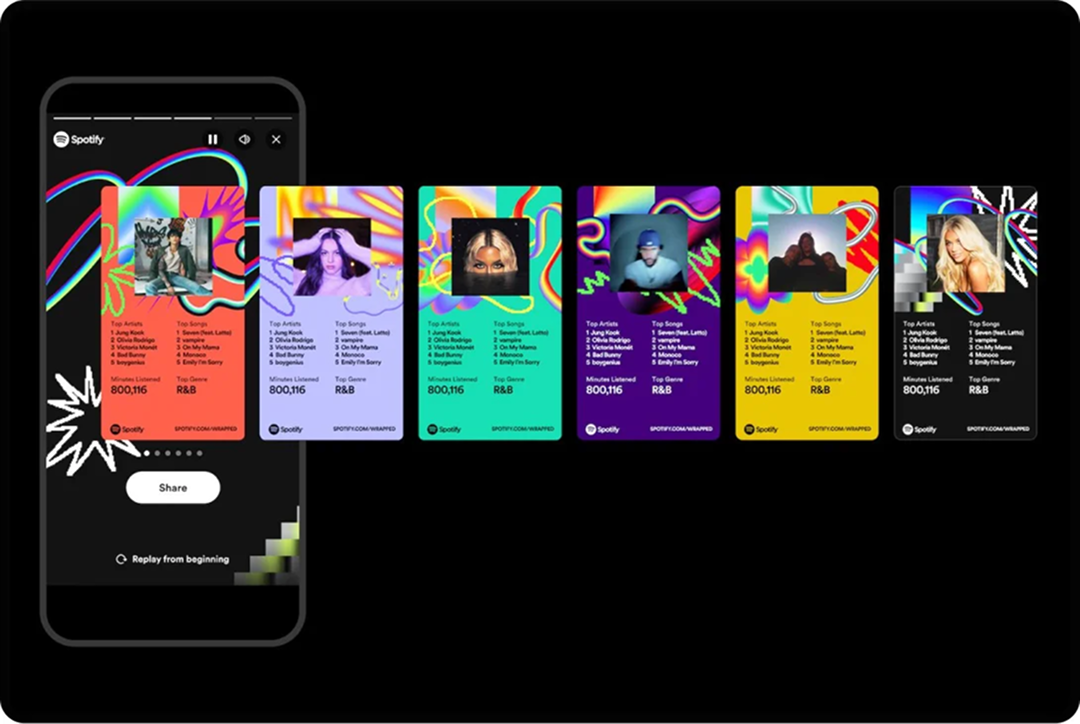
Content Marketing & Social Search
Search is evolving—fast. While Google has long been the dominant player in how people discover information online, a growing share of users, especially Gen Z, are turning to platforms like TikTok, Instagram, and YouTube as their first stop when searching for ideas, recommendations, and answers. This shift is redefining what it means to “search,” and it’s reshaping how content marketers need to show up.
Enter social search—the merging of discovery and entertainment. Instead of typing “best brunch spots in London” into Google, a user might now type the same into TikTok’s search bar and get instant results: visually-appealing videos, voiceovers, first-hand reviews, and real-time reactions. It’s visual, personalized, and algorithm-driven, offering content that feels more trustworthy because it’s from people, not publishers.TikTok, in particular, has leaned into this behavior. The platform now actively enhances SEO through features like keyword prompts in captions, auto-suggest in the search bar, and indexed video transcripts. Creators and brands alike are optimizing posts with searchable titles, hashtags, and on-screen text, treating TikToks more like micro-pages than fleeting clips. In other words, TikTok is becoming a search engine.
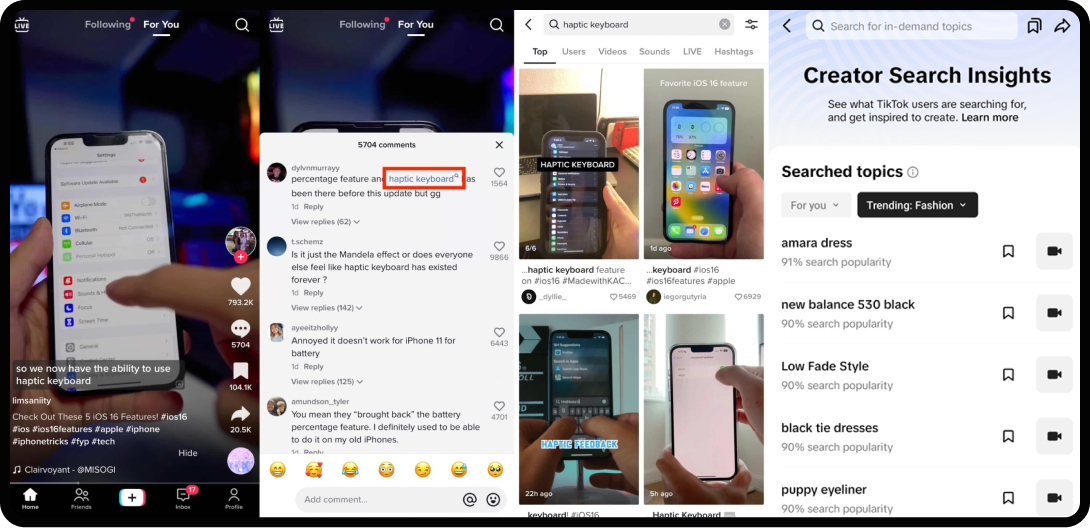
For content marketers, this opens up a new playing field. It’s no longer just about ranking on Google, it’s about showing up where your audience is already searching, scrolling, and sharing. That means developing content that’s not only keyword-rich but also format-aware and platform-native.
Whether it’s a listicle turned into a short-form video or a how-to guide broken down into visual snippets, successful content now needs to travel across both search engines and social feeds.
Content Marketing & Social Listening
Content marketing isn’t just about publishing, it’s about listening. The best-performing content doesn’t start with brainstorming in a vacuum. It begins with real-time insights into what your audience is already saying, searching, and sharing. That’s where social listening becomes a key ingredient in any successful content marketing strategy.
Social listening involves monitoring social media, forums, blogs, and other online platforms to understand what people are saying, not just about your brand, but about your industry and the broader culture. It goes beyond tracking mentions; it’s about uncovering sentiment, questions, pain points, and emerging trends.
By tapping into social listening, brands unlock valuable insights that can inform content strategies in meaningful and relevant ways:
- Trend Spotting: Hear what’s trending before it peaks. From viral sounds on TikTok to hot-button topics on X (formerly Twitter), social listening helps brands jump on cultural conversations with timely, relevant content.
- Customer Pain Points: What are people struggling with or asking about repeatedly? These insights can fuel educational blogs, product explainers, or help content.
- Content Format Preferences: Are audiences leaning into memes, carousel infographics, or short-form video lately? Social listening helps you catch format shifts early.
- Language & Tone: Hearing how your audience talks—their slang, humor, or acronyms — can help you mirror that tone back in a way that feels authentic.
- Gap Analysis: Social chatter often reveals what consumers aren’t getting from current content or competitors, allowing you to fill that void.
For example, Glossier has famously leaned into social listening from day one. Its product development and content strategy are deeply rooted in community feedback—much of it gathered informally from DMs, comments, and Reddit threads. Glossier doesn’t just “read the room”—it builds the room based on what its audience is asking for.
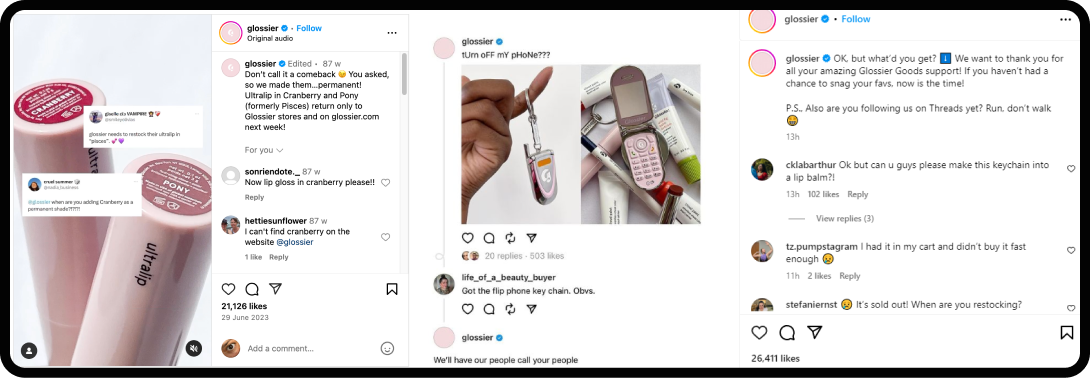
SEO & Content Marketing
While SEO is the technical framework that ensures your content is discoverable, content marketing is what gives people a reason to click, stay, and convert.
A strong content marketing strategy is the backbone of effective SEO. It’s about understanding what your audience is searching for, then creating content that answers their questions, solves their problems, or satisfies their curiosity—all while incorporating smart, strategic keyword use.
But SEO isn’t just about algorithms—it’s about people. Search engines reward content that’s helpful, informative, and trustworthy. That’s why the most successful SEO (and AEO) strategies are built on content that balances optimization with real human value.
Why Is Content Marketing Important?
When done correctly and successfully, content marketing can increase revenue or conversion rates, foster customer loyalty, generate leads, and improve overall brand reputation. Here’s a snapshot of some of the many ways content marketing can help brands and businesses grow:
- Businesses with blogs get 67% more leads than other companies—aka just one of the many reasons why we write articles like this one!
- 83% of Instagram users discover new products or services on the platform
- 50% of people buy from marketing emails at least once per month
- 47% of users report they bought something they saw on TikTok
In addition to these holistic benefits, content marketing also has different, more specific benefits at each stage of the consumer decision-making process.
- During the Need Recognition phase, content marketing can help educate potential customers on how their pain points can be addressed and generate awareness around the brand.
- During the Information Search phase, content marketing can provide specific information that a potential customer is looking for, therefore easing uncertainties and fostering trust.
- In the Alternative Evaluation phase, content marketing can give side-by-side comparisons that not only make the (often lengthy) evaluation process easier but also give further insight into how the potential customer can benefit from their possible purchase decision.
- At the Purchase Decision phase, content marketing can drive conversion rates by linking relevant and valuable content with compelling CTAs.
- During the Post-Purchase phase, content marketing can continue to provide engaging and shareable content that can lead to organic referrals and positive word of mouth.
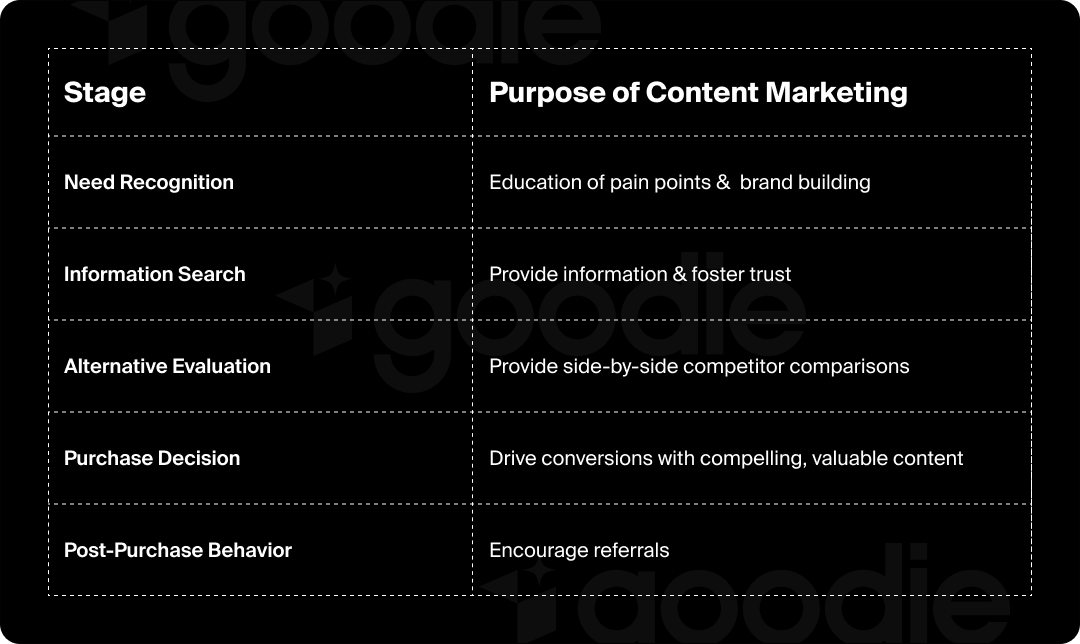
The benefits of content marketing are substantial—and so are the opportunities to leverage its unique, full-funnel capabilities. While it’s easy to get caught up in the granular goals of each individual piece of content, it’s important to note that content marketing is holistically valuable because it tells an overall brand story.
Every piece of content, whether it’s designed to educate or convert, contributes to building a bigger picture of who the brand is and what it stands for, which in turn retains a community of long-term, engaged, and loyal customers.
What Is a Content Marketing Strategy?
Once you understand what content marketing is and how it drives impact across the funnel, the next step is building a content marketing strategy that’s actually aligned to your brand goals, audience behavior, and platform dynamics.
This doesn’t just mean planning blog posts and newsletters—it means thinking multi-format, multi-platform, and audience-first. A strong content strategy outlines not only what you’ll say, but why, where, and how often—all rooted in the ever-evolving way people consume and discover content today.
Here are the four core components of a modern content marketing strategy:
1. Purpose & Goals
What’s the reason for your content? Are you trying to drive brand awareness, educate potential customers, improve SEO rankings, or fuel conversions? Are you aiming to rank on Google or be discovered on TikTok? A clear goal upfront will shape everything that follows, from tone to format to distribution.
2. Audience & Behavior
Who exactly are you trying to reach—and more importantly, where and how do they consume content in 2025? Is your audience Gen Z relying on TikTok for discovery? Are they B2B decision-makers scrolling LinkedIn over coffee? Your content needs to reflect the style, format, and pace of the platforms they spend time on.
Don’t assume—do your research. Use social listening tools, trend reports, and audience insights to understand what your audience wants and expects from content today.
3. Content Types, Formats & Cadence
A modern content strategy should go beyond blog posts and static assets. Think:
- Short-form video (for social search and platforms like TikTok, Instagram Reels, etc.)
- Creator partnerships and UGC
- Long-form thought leadership
- Snackable carousel posts
- Interactive stories or quizzes
Match the format to the funnel. Top-of-funnel content might lean more social and visual, while bottom-of-funnel content could live in emails or gated landing pages. Cadence matters too — content is no longer “set it and forget it.” Regular publishing, repurposing, and real-time responsiveness are key.
4. Measurement & Optimization Plan
Content without a measurement plan is just noise. Make sure you know what success looks like and how you’ll track it. Use platform-native metrics and cross-channel data to inform what’s working—and what needs to shift.
A few updated KPI frameworks to match today’s channels:
- Awareness → Impressions, reach, video views (especially on TikTok/IG Reels/YouTube Shorts)
- Consideration → Saves, comments, shares, time on page
- Conversion → CTR, purchases, form submissions, affiliate link performance
- Loyalty → Repeat engagement, newsletter opens, customer retention rate
- Advocacy → UGC participation, social shares, reviews, tagged mentions
What Does a Content Marketer Do?
It seems like we’re living in a time of AI-generated everything, where content is being produced faster than ever, but speed alone doesn’t equal impact. What separates noise from resonance is still strategy, creativity, and a deep understanding of what audiences actually want.
That’s where content marketers come in.
Far from being replaced by AI, today’s best content marketers are using it as a tool to move faster, think bigger, and stay sharp in an increasingly crowded digital landscape.
So, what does a modern content marketer do?
They’re still storytellers. Still strategists. But now they’re also:
- AI-Augmented Creators: Content marketers are using AI tools to brainstorm headlines, summarize research, generate first drafts, and even test tone variations. But they don’t blindly copy-paste. They refine, fact-check, and humanize—turning AI outputs into brand-right, audience-ready content.
- Platform-Native Thinkers: From SEO on Google to discoverability on TikTok, today’s content marketer understands how algorithms work—and how to make content that works with them. They know that social search is rising, attention spans are shrinking, and content needs to earn its place in-feed.
- Editors-in-Chief of the Brand: They set and enforce content standards, ensuring everything from blogs to Reels reflects the brand’s voice, values, and POV. In an AI-saturated landscape, consistency and originality are key brand differentiators.
- Experimenters & Analysts: They run tests, analyze performance, and adapt quickly. AI tools make it easier to synthesize insights across platforms—but a good content marketer knows which metrics matter, and when to pivot based on what the data is saying.
- Creative Collaborators: Whether briefing AI tools, video editors, or external creators, content marketers are orchestrating the entire content engine—aligning brand, SEO, social, lifecycle, and product teams around a shared content vision.
With increasingly rapid developments in AI tech, a content marketer’s value isn’t just in producing content—it’s in knowing what to say, how to say it, where it should live, and why it matters. The future of content isn’t AI vs. human—it’s AI plus human-led thinking, with the content marketer leading the charge.
What Are Some Examples of Content Marketing?
Content marketing thrives when it’s authentic, audience-first, and culturally attuned. These five brands—WHOOP, Skims, HOKA, Liquid Death, and Sweetgreen—demonstrate how to build brand equity and drive growth through content that informs, entertains, and connects.
1. WHOOP
WHOOP’s content strategy is rooted in education and community. Through “The WHOOP Podcast,” the brand delves into topics like strain, recovery, and stress, featuring expert guests and founder Will Ahmed himself. These discussions are repurposed into bite-sized clips for social media, making complex health insights accessible and engaging.

2. Skims
Instead of partnering for mere visibility, Skims times its campaigns with peak cultural relevance, transforming drops into moments that dominate the digital conversation. From teaming up with Charli XCX during peak brat summer to launching a star-studded Team USA campaign ahead of the Paris Olympics, their partnerships double as timely, buzzworthy content drops.
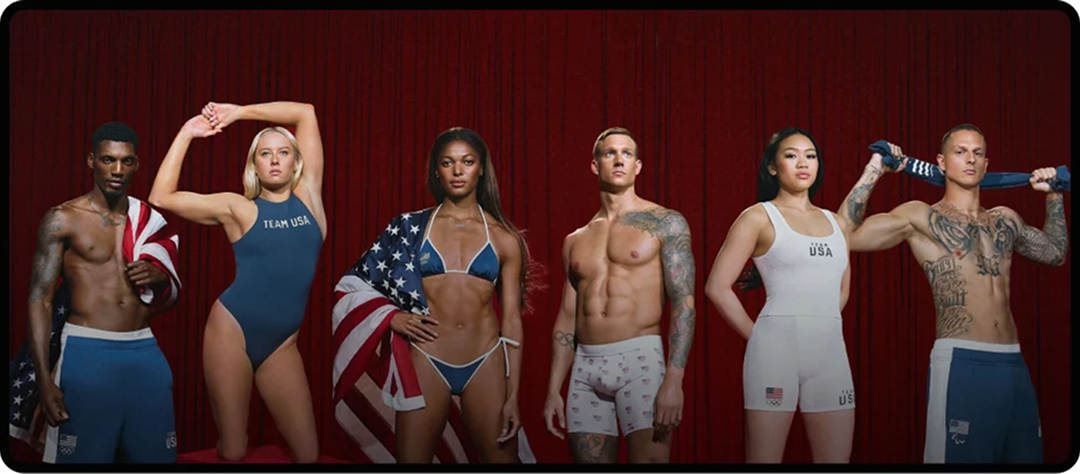

3. HOKA
HOKA leans into expert advocacy by partnering with podiatrists—a smart move, especially for runners dealing with plantar fasciitis, a condition that affects 1 in 10. These partnerships show up in content across key touchpoints: from testimonials on HOKA’s site to features on the AAPSM website, reinforcing the brand’s authority, trust, and real-world impact.
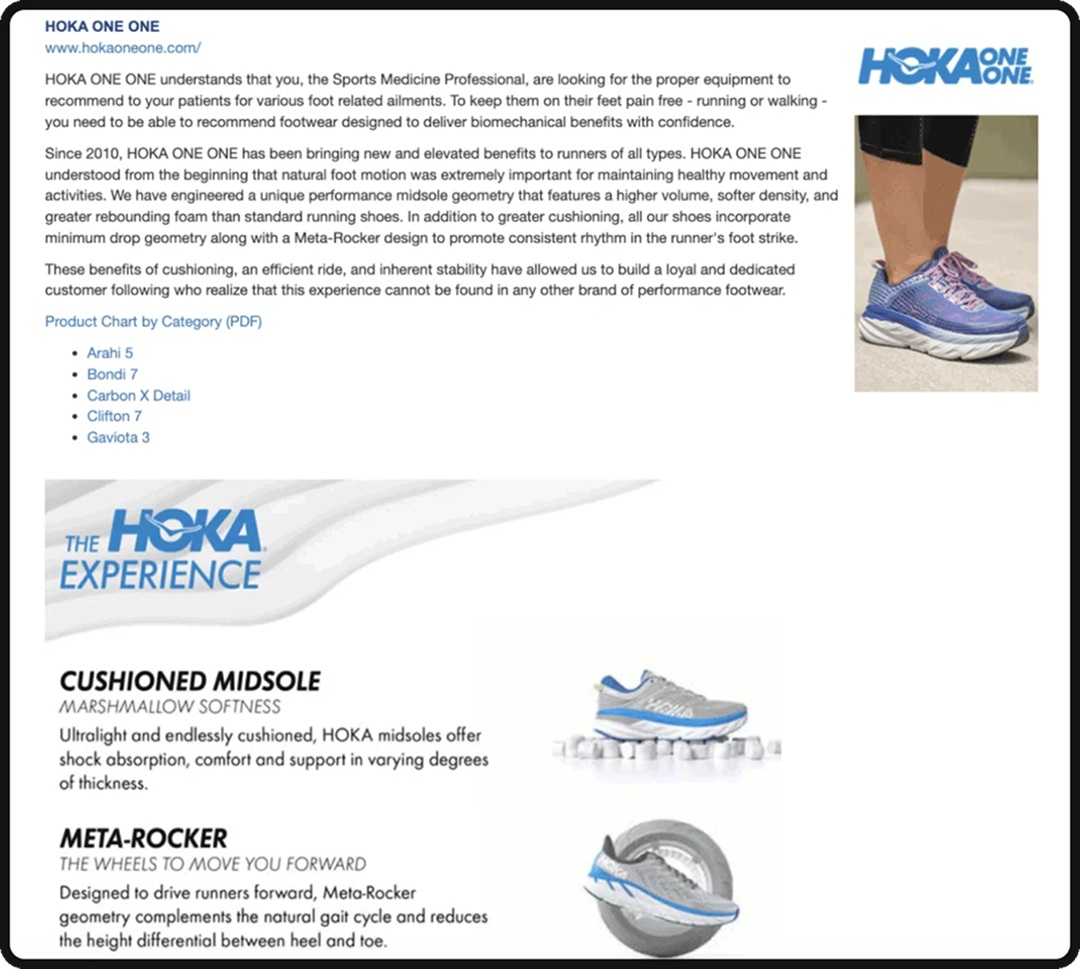
4. Sweetgreen
Sweetgreen turns its mobile app into a content marketing engine—delivering value not just through salads, but through a curated digital experience. From personalized recommendations and nutrition insights to in-app storytelling around seasonal ingredients, the app reinforces Sweetgreen’s brand values at every touchpoint.With the launch of Sweetpass+, a $10/month subscription program, Sweetgreen doubled down on content-driven loyalty. Exclusive offers, early access to new menu drops, and push notifications that feel more like brand moments than promos—every feature is designed to keep customers engaged with the brand story, not just the product.
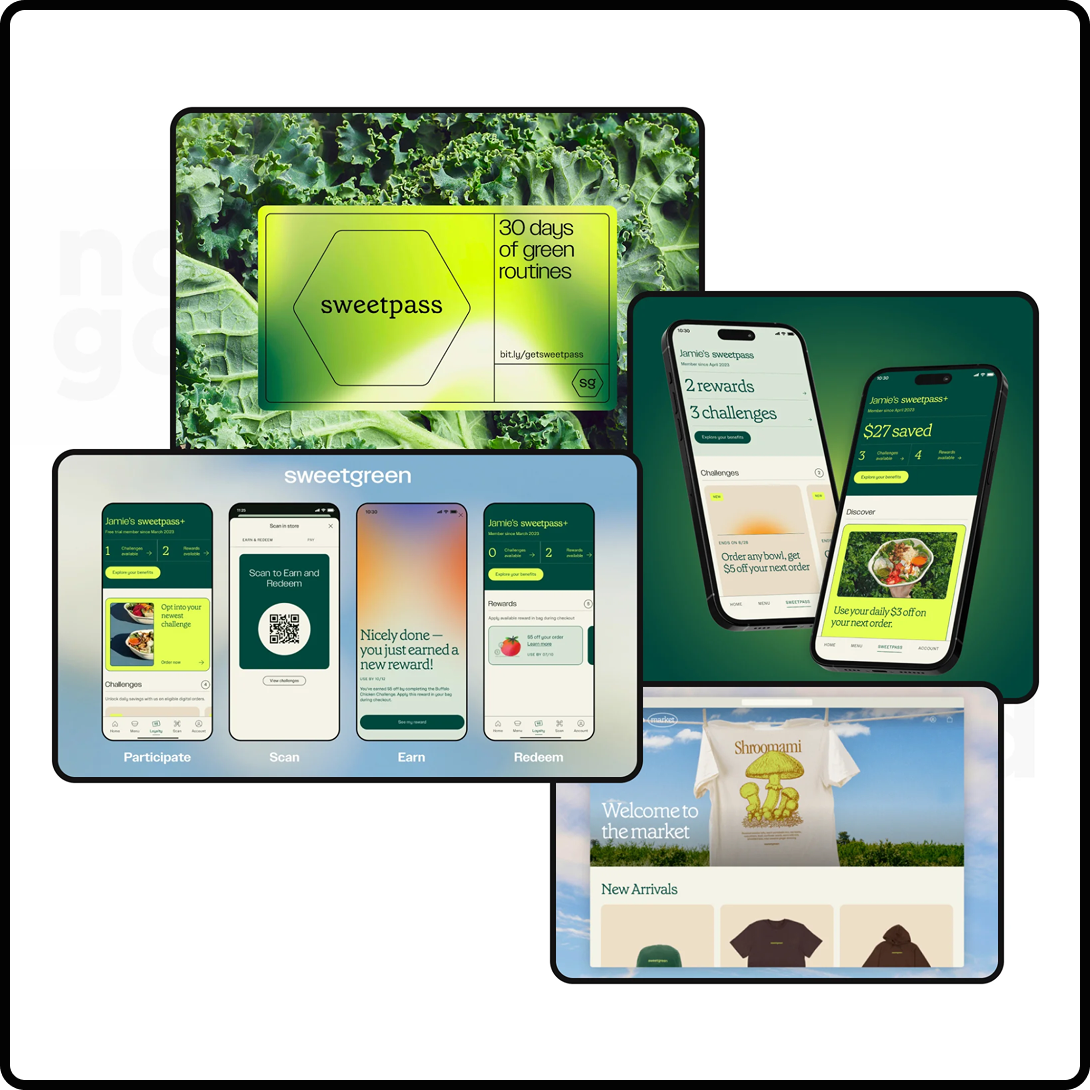
How to Build a Content Marketing Strategy
A strong content marketing strategy delivers valuable, consistent, and targeted touchpoints across every stage of the marketing funnel. Consumers at each phase—awareness, consideration, conversion, loyalty, and advocacy—have different priorities and engage with content in different ways.
For example, Someone in the awareness stage might casually browse a brand’s TikTok to get a feel for the product, while a loyal customer in the advocacy stage might regularly share branded playlists with a friend.
Let’s break it down with best-in-class examples of how brands are utilizing content at every stage of the marketing funnel.
Step 1: Build Awareness
Awareness is often mistakenly seen as the easiest stage of the marketing funnel; yet what many don’t realize is that building awareness places a specific emphasis on the difficult balance between appropriately featuring the product or service without trying too hard.
Although this is done at all stages of the marketing funnel, customers in the awareness stage are particularly sensitive to product pushes as they’re still considering many other brands in the market.
Brand example: Olipop
Content type: TikTok
Olipop’s TikTok video about “what your grocery store says about you” is one example of this balance. This humor-driven short-form video provides value to the Gen Z target consumer through entertainment and relatability.
Although the video content itself clearly features the product being sold, the tone and messaging are more lifestyle-driven rather than sales-driven. Even the call to action, “let us know what grocery store to do next”, is pushing for engagement rather than conversion.
By focusing on the primary goal of building awareness, Olipop avoids alienating potential customers that may not be ready to make the purchase just yet.
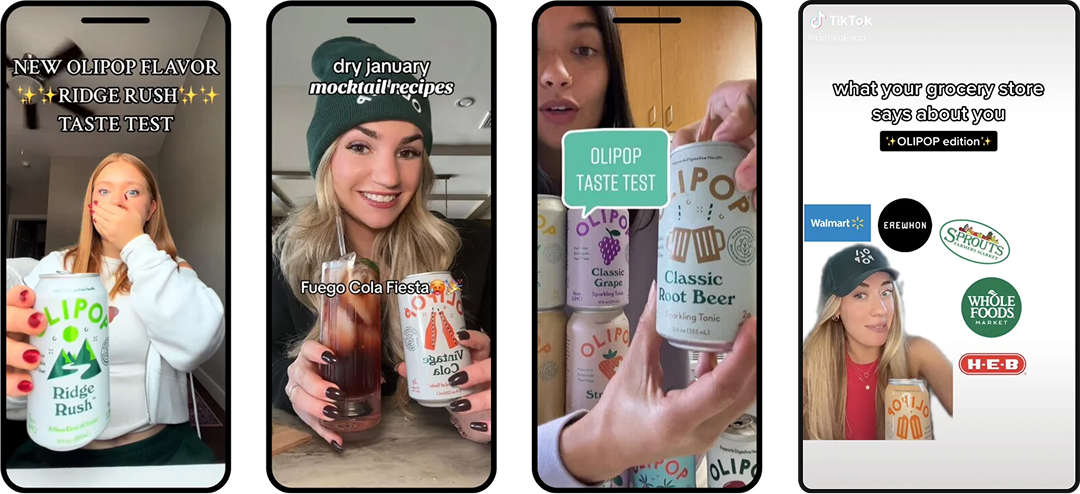
It’s important to note that TikTok is also particularly well-suited for building awareness through content marketing, as brand videos can appear on a user’s For You page through the TikTok algorithm, even if the user isn’t following the brand.
Step 2: Improve Consideration
During the consideration stage, a potential customer is primarily looking for information on the product or service, on potential alternatives, or specific key value propositions. Therefore, content marketing at the consideration stage should aim to educate and inform, while also positioning your brand as a knowledgeable industry expert.
Long-form content like blog posts and articles provides ample real estate to dive deeper into brand and product information, making it well-suited for the consideration stage.
Brand example: Maude
Content type: Blog Post
Take Maude, for example. The modern sexual wellness brand runs a blog, aptly named The Maudern, featuring articles on topics ranging from sex education to relationship science.
Like Olipop’s TikToks, Maude’s blog content isn’t directly tied to their product offerings; instead, The Maudern focuses on providing valuable insights on modern intimacy, fostering a reciprocal relationship with potential customers as they seek information.
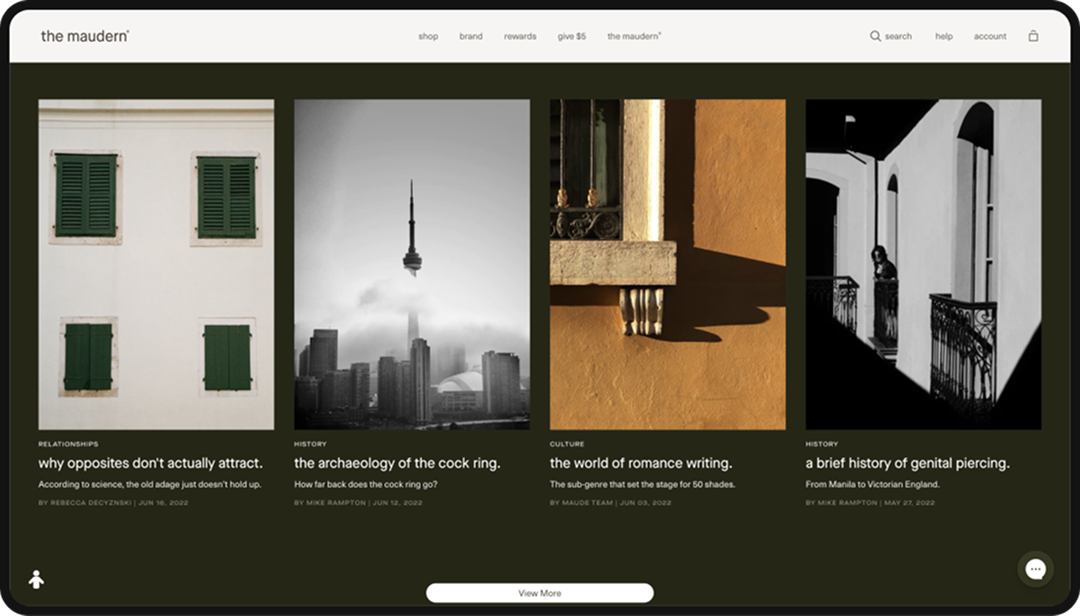
Brand example: Oura
Content type: Blog & Resource Hub
Oura, the smart ring brand focused on sleep and wellness, uses its blog to deepen consumer education around sleep science, health optimization, and wearable tech. Instead of emphasizing product specs, Oura’s content focuses on topics like “How to Improve Your Sleep Score” or “What Your HRV Really Means,” tapping into the curiosity and concerns of potential buyers.
By turning common questions into high-value, SEO-friendly content, the blog both educates readers and positions the Oura Ring as the natural solution. The blog plays a crucial role in guiding health-conscious users through informed consideration—and ultimately, conversion.
In both examples, these brands leverage content not just to fill space, but to build trust, authority, and brand alignment at a critical point in the customer journey.

Step 3: Drive Conversion
The conversion stage is the most straightforward of all the stages. Having established awareness and improved consideration, potential customers are finally ready to make their purchase decision, albeit not without a little push.
Brand example: Magic Spoon
Content type: Email
Magic Spoon’s email content combines audience-relevant, value-driven messaging with compelling CTAs to drive conversions. With the average person receiving over 100 emails daily, simply pairing a product image with a “Buy Now” button isn’t enough.
This is where content marketing shines. Magic Spoon’s emails blend product education and social proof with action-oriented messaging, building a strong foundation beneath the CTA.
Content marketing intersects with email marketing by delivering relevant information consumers actually want to read, creating an end-to-end, seamless experience that supports and justifies their purchase decision.

Step 4: Foster Loyalty
Customer loyalty is one of the hardest—but also one of the most valuable—aspects of brand-building to master. At its core, loyalty stems from consistent, meaningful engagement. It’s about creating a long-term relationship where the customer trusts the brand enough to skip the awareness and consideration phases entirely when it’s time for their next purchase.
Brand example: Away
Content type: Instagram posts
Content formats with high engagement potential are generally best suited for fostering loyalty. For example, travel brand Away’s Instagram features a variety of quizzes, word searches, bingo boards, and memes that encourage easy user engagement. CTAs like “build your combo below” or “comment yours below” prompt consumers to interact with the brand consistently, even if that interaction is outside of the product and sales realm (for now).
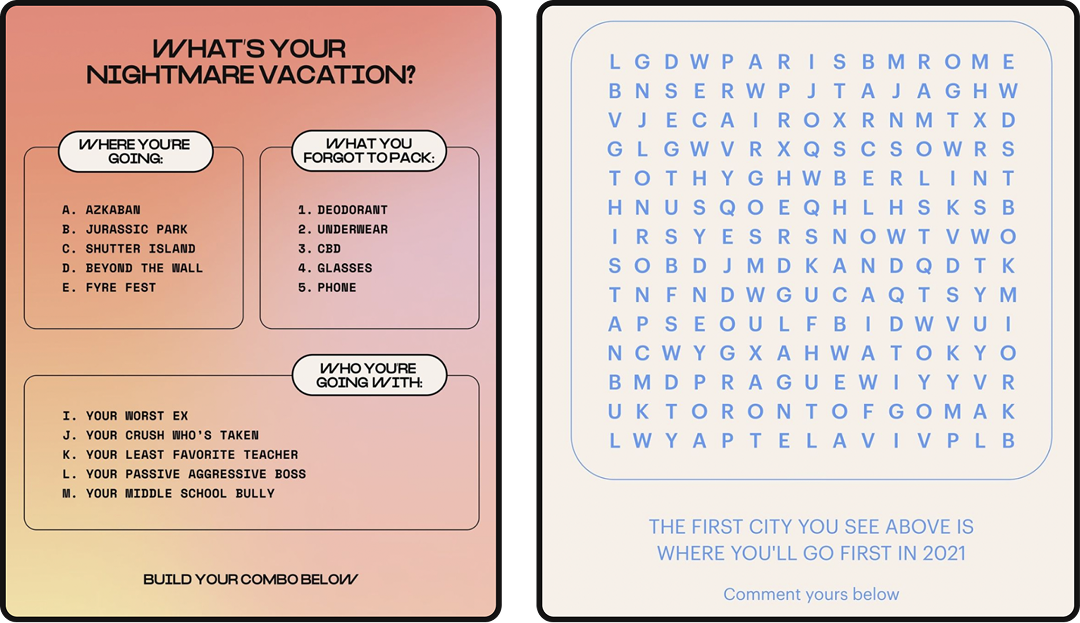
The more valuable, relevant, and engaging the content a brand provides, the more likely customers are to return. Content consumed between purchases keeps the brand top of mind.
At the loyalty stage, content marketing aims to position the brand as one that truly understands the customer, organically, yet strategically, becoming a part of their life.
Step 5: Stimulate Advocacy
The last stage of the marketing funnel is advocacy: stimulating organic sharing and positive word-of-mouth to acquire new customers through existing ones. The key to content marketing at the advocacy stage is to create content that lends itself to being shareable, such as playlists, recipes, memes, etc.
Brand example: Letterboxd
Content type: Movie lists
Letterboxd grows by turning its users into storytellers through user-generated reviews and curated movie lists. This content sparks authentic conversations and sharing within communities, naturally expanding Letterboxd’s reach.
By spotlighting standout user content on social channels and newsletters, Letterboxd encourages more participation and sharing. This approach creates positive word-of-mouth, acquiring new users organically through existing fans.

Content marketing is a marathon, not a sprint. Still, the long game of content marketing is not without its checkpoints, and it’s essential to understand the specific goals of each stage, along with the content formats and channels best suited to achieve them.
When leveraged correctly, content marketing can meet consumers exactly where they are and give them exactly what they’re looking for, all while addressing the pain points they may have.
If you’re ready to kickstart your content marketing strategy, here are some next steps you might want to check out:
- Want to learn more about content marketing? Read about how Our Place used branded content to achieve exponential growth
- Want to start using short-form videos for your content marketing strategy? Read up on the difference between Instagram Reels, TikTok, and Youtube Shorts
- All set to use content marketing for your brand? Talk to our experts to start making it work.





